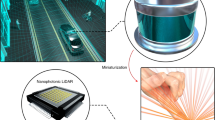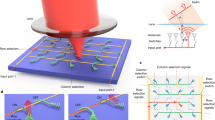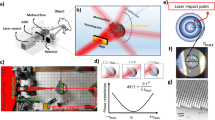Abstract
Light detection and ranging (LiDAR) technology is an active remote-sensing system used in autonomous vehicles, machine vision and augmented reality. Improvements in the speed and signal-to-noise ratio of photodetectors are needed to meet these demanding ranging applications. Silicon electronics have been the principal option for LiDAR photodetectors in the range of 850–950 nm. However, its indirect bandgap leads to a low absorption coefficient in the near-infrared region, as well as a consequent trade-off between speed and efficiency. Here we report solution-processed lead–tin binary perovskite photodetectors that have an external quantum efficiency of 85% at 850 nm, dark current below 10–8 A cm–2 and response time faster than 100 ps. The devices are fabricated using self-limiting and self-reduced tin precursors that enable perovskite crystallization at the desired stoichiometry and prevent the formation of interfacial defects with the hole transport layer. The approach removes oxygen from the solution, converts Sn4+ to Sn2+ through comproportionation, and leaves neither metallic tin nor SnOx residues. To illustrate the potential of these solution-processed perovskite photodetectors in LiDAR, we show that they can resolve sub-millimetre distances with a typical 50 µm standard deviation.
This is a preview of subscription content, access via your institution
Access options
Access Nature and 54 other Nature Portfolio journals
Get Nature+, our best-value online-access subscription
$29.99 / 30 days
cancel any time
Subscribe to this journal
Receive 12 digital issues and online access to articles
$119.00 per year
only $9.92 per issue
Buy this article
- Purchase on Springer Link
- Instant access to full article PDF
Prices may be subject to local taxes which are calculated during checkout





Similar content being viewed by others
Data availability
The datasets generated during and/or analysed during the current study are available from the corresponding author on reasonable request.
References
Royo, S. & Ballesta-Garcia, M. An overview of LiDAR imaging systems for autonomous vehicles. Appl. Sci. 9, 4093 (2019).
Behroozpour, B., Sandborn, P. A. M., Wu, M. C. & Boser, B. E. LiDAR system architectures and circuits. IEEE Commun. Mag. 55, 135–142 (2017).
Yatsui, T. et al. Enhanced photo-sensitivity in a Si photodetector using a near-field assisted excitation. Commun. Phys. 2, 62 (2019).
Noffsinger, J., Kioupakis, E., Walle, C. G., Van de, Louie, S. G. & Cohen, M. L. Phonon-assisted optical absorption in silicon from first principles. Phys. Rev. Lett. 108, 167402 (2012).
Meredith, P. & Armin, A. Scaling of next generation solution processed organic and perovskite solar cells. Nat. Commun. 9, 5261 (2018).
Fu, F. et al. High-efficiency inverted semi-transparent planar perovskite solar cells in substrate configuration. Nat. Energy 2, 16190 (2016).
Kim, Y. C. et al. Printable organometallic perovskite enables large-area, low-dose X-ray imaging. Nature 550, 87–91 (2017).
Saliba, M., Correa-Baena, J.-P., Grätzel, M., Hagfeldt, A. & Abate, A. Perovskite solar cells: from the atomic level to film quality and device performance. Angew. Chem. Int. Ed. 57, 2554–2569 (2018).
García De Arquer, F. P., Armin, A., Meredith, P. & Sargent, E. H. Solution-processed semiconductors for next-generation photodetectors. Nat. Rev. Mater. 2, 16100 (2017).
Zhou, J. et al. Lead-free perovskite derivative Cs2SnCl6−xBrx single crystals for narrowband photodetectors. Adv. Opt. Mater. 7, 1900139 (2019).
Stranks, S. D. et al. Electron-hole diffusion lengths exceeding 1 micrometer in an organometal trihalide perovskite absorber. Science 342, 341–344 (2013).
Fu, Y. et al. Metal halide perovskite nanostructures for optoelectronic applications and the study of physical properties. Nat. Rev. Mater. 4, 169–188 (2019).
Correa-Baena, J.-P. et al. Promises and challenges of perovskite solar cells. Science 358, 739–744 (2017).
Dou, L. et al. Solution-processed hybrid perovskite photodetectors with high detectivity. Nat. Commun. 5, 5404 (2014).
Werner, J. et al. Improving low-bandgap tin–lead perovskite solar cells via contact engineering and gas quench processing. ACS Energy Lett. 5, 1215–1223 (2020).
Lin, R. et al. Monolithic all-perovskite tandem solar cells with 24.8% efficiency exploiting comproportionation to suppress Sn(ii) oxidation in precursor ink. Nat. Energy 4, 864–873 (2019).
Prasanna, R. et al. Design of low bandgap tin–lead halide perovskite solar cells to achieve thermal, atmospheric and operational stability. Nat. Energy 4, 939–947 (2019).
Lee, S., Ha, T. J. & Kang, D. W. Mixed-halide Pb-Sn binary perovskite films with various Sn-content for Pb-reduced solar cells. Mater. Lett. 227, 311–314 (2018).
Jiang, T. et al. Realizing high efficiency over 20% of low-bandgap Pb–Sn-alloyed perovskite solar cells by in situ reduction of Sn4+. Sol. RRL 4, 1900467 (2020).
Ghimire, N. et al. Mitigating open-circuit voltage loss in Pb–Sn low-bandgap perovskite solar cells via additive engineering. ACS Appl. Energy Mater. 4, 1731–1742 (2021).
Tai, Q. et al. Antioxidant grain passivation for air-stable tin-based perovskite solar cells. Angew. Chem. Int. Ed. 58, 806–810 (2019).
Ma, L. et al. Carrier diffusion lengths of over 500 nm in lead-free perovskite CH3NH3SnI3 films. J. Am. Chem. Soc. 138, 14750–14755 (2016).
Lee, S. J. et al. Fabrication of efficient formamidinium tin iodide perovskite solar cells through SnF2–pyrazine complex. J. Am. Chem. Soc. 138, 3974–3977 (2016).
Liao, W. et al. Lead-free inverted planar formamidinium tin triiodide perovskite solar cells achieving power conversion efficiencies up to 6.22%. Adv. Mater. 28, 9333–9340 (2016).
Konstantakou, M. & Stergiopoulos, T. A critical review on tin halide perovskite solar cells. J. Mater. Chem. A 5, 11518–11549 (2017).
Ke, W. et al. Ethylenediammonium-based ‘hollow’ Pb/Sn perovskites with ideal band gap yield solar cells with higher efficiency and stability. J. Am. Chem. Soc. 141, 8627–8637 (2019).
Xiao, K. et al. All-perovskite tandem solar cells with 24.2% certified efficiency and area over 1 cm2 using surface-anchoring zwitterionic antioxidant. Nat. Energy 5, 870–880 (2020).
Gu, F. et al. Improving performance of lead-free formamidinium tin triiodide perovskite solar cells by tin source purification. Sol. RRL 2, 1800136 (2018).
Zhang, J. et al. Solution-processed Sr-doped NiOx as hole transport layer for efficient and stable perovskite solar cells. Sol. Energy 174, 1133–1141 (2018).
Liu, A. et al. Hole mobility modulation of solution-processed nickel oxide thin-film transistor based on high-k dielectric. Appl. Phys. Lett. 108, 233506 (2016).
Kung, P.-K. et al. A review of inorganic hole transport materials for perovskite solar cells. Adv. Mater. Interfaces 5, 1800882 (2018).
Chang, C.-C., Tao, J.-H., Tsai, C.-E., Cheng, Y.-J. & Hsu, C.-S. Cross-linked triarylamine-based hole-transporting layer for solution-processed PEDOT:PSS-free inverted perovskite solar cells. ACS Appl. Mater. Interfaces 10, 21466–21471 (2018).
Chi, D. et al. Composition and interface engineering for efficient and thermally stable Pb–Sn mixed low-bandgap perovskite solar cells. Adv. Funct. Mater. 28, 1804603 (2018).
Jeng, J.-Y. et al. Nickel oxide electrode interlayer in CH3NH3PbI3 perovskite/PCBM planar-heterojunction hybrid solar cells. Adv. Mater. 26, 4107–4113 (2014).
You, J. et al. Improved air stability of perovskite solar cells via solution-processed metal oxide transport layers. Nat. Nanotechnol. 11, 75–81 (2015).
Fang, Z., Xiao, K. & Tan, H. Low-temperature processed inorganic hole transport layer for efficient and stable mixed Pb-Sn low-bandgap perovskite solar cells. Sci. Bull. 64, 1399 (2019).
Lee, S. J. et al. Reducing carrier density in formamidinium tin perovskites and its beneficial effects on stability and efficiency of perovskite solar cells. ACS Energy Lett. 3, 46–53 (2017).
Diau, E. W.-G., Jokar, E. & Rameez, M. Strategies to improve performance and stability for tin-based perovskite solar cells. ACS Energy Lett. 4, 1930–1937 (2019).
Lin, Q., Armin, A., Nagiri, R. C. R., Burn, P. L. & Meredith, P. Electro-optics of perovskite solar cells. Nat. Photon. 9, 106–112 (2014).
Walsh, A. & Stranks, S. D. Taking control of ion transport in halide perovskite solar cells. ACS Energy Lett. 3, 1983–1990 (2018).
Hauff, Evon Impedance spectroscopy for emerging photovoltaics. J. Phys. Chem. C 123, 11329–11346 (2019).
Shi, J. et al. From ultrafast to ultraslow: charge-carrier dynamics of perovskite solar cells. Joule 2, 879–901 (2018).
Zarazua, I. et al. Surface recombination and collection efficiency in perovskite solar cells from impedance analysis. J. Phys. Chem. Lett. 7, 5105–5113 (2016).
Mahmood, K., Sarwar, S. & Mehran, M. T. Current status of electron transport layers in perovskite solar cells: materials and properties. RSC Adv. 7, 17044–17062 (2017).
Brandt, R. E., Stevanović, V., Ginley, D. S. & Buonassisi, T. Identifying defect-tolerant semiconductors with high minority-carrier lifetimes: beyond hybrid lead halide perovskites. MRS Commun. 5, 265–275 (2015).
Blum, V. et al. Ab initio molecular simulations with numeric atom-centered orbitals. Comput. Phys. Commun. 180, 2175–2196 (2009).
Havu, V., Blum, V., Havu, P. & Scheffler, M. Efficient O(N) integration for all-electron electronic structure calculation using numeric basis functions. J. Comput. Phys. 228, 8367–8379 (2009).
Ren, X. et al. Resolution-of-identity approach to Hartree–Fock, hybrid density functionals, RPA, MP2 and GW with numeric atom-centered orbital basis functions. New J. Phys. 14, 053020 (2012).
Weston, L., Tailor, H., Krishnaswamy, K., Bjaalie, L. & Van de Walle, C. G. Accurate and efficient band-offset calculations from density functional theory. Comput. Mater. Sci. 151, 174–180 (2018).
Li, C. et al. Ultrafast and broadband photodetectors based on a perovskite/organic bulk heterojunction for large-dynamic-range imaging. Light Sci. Appl. 9, 31 (2020).
Zheng, T. et al. Polymer: fullerene bimolecular crystals for near-infrared spectroscopic photodetectors. Adv. Mater. 29, 1702184 (2017).
Yao, Y. et al. Plastic near-infrared photodetectors utilizing low band gap polymer. Adv. Mater. 19, 3979–3983 (2007).
Kim, J. Y. et al. Single-step fabrication of quantum funnels via centrifugal colloidal casting of nanoparticle films. Nat. Commun. 6, 7772 (2015).
Wang, W. et al. Highly sensitive low-bandgap perovskite photodetectors with response from ultraviolet to the near-infrared region. Adv. Funct. Mater. 27, 1703953 (2017).
Shen, L. et al. Integration of perovskite and polymer photoactive layers to produce ultrafast response, ultraviolet-to-near-infrared, sensitive photodetectors. Mater. Horiz. 4, 242–248 (2017).
Clifford, J. P. et al. Fast, sensitive and spectrally tuneable colloidal-quantum-dot photodetectors. Nat. Nanotechnol. 4, 40–44 (2009).
Acknowledgements
This work was supported by the Natural Sciences and Engineering Research Council (NSERC) Alexander Graham Bell Canada Graduate Scholarships (CGS-D), Materials for Enhanced Energy Technologies (MEET) scholarships and the NSERC Collaborative Research and Training Experience (CREATE) program (grant no. 466083). F.P.G.A. acknowledges funding from CEX2019- 000910-S (MCIN/ AEI/10.13039/501100011033), Fundació Cellex, Fundació Mir-Puig, Generalitat de Catalunya through CERCA.
Author information
Authors and Affiliations
Contributions
A.M.N., F.P.G.A. and E.H.S. conceived the idea and designed the experiments. M.W. contributed to the initial fabrication and speed measurements. A.M.N. and M.V. modelled the device performance and also fabricated the devices. M.V. measured the EQE and dark current of the device. A.M.N. performed the TPC measurement and LiDAR demo. T.Z. performed the theoretical calculation for SnOx energy level. E.H.S., S.H., M.I.S. and Y.H. provided advice. A.M.N., A.J., M.V., F.P.G.A. and E.H.S. composed the manuscript. All the authors discussed the results and commented on the manuscript.
Corresponding authors
Ethics declarations
Competing interests
The authors declare no competing interests.
Peer review
Peer review information
Nature Electronics thanks the anonymous reviewers for their contribution to the peer review of this work.
Additional information
Publisher’s note Springer Nature remains neutral with regard to jurisdictional claims in published maps and institutional affiliations.
Extended data
Extended Data Fig. 1 Performance modeling of the photodetector.
Equations are provided in Methods section. a, Percentage of absorbed light vs. thickness at indicated absorption coefficients. EQE and bandwidth of b, Silicon and c, PbSn perovskite vs. film thickness. d, Comparison of silicon and PbSn perovskite from the last two panels. Parameters used for the modeling are given in Extended Data Fig. 2a.
Extended Data Fig. 2 Combined speed × efficiency characteristic of the photodetector.
a, Parameters used in the modeling of PbSn and Silicon photodetectors. b, Combined speed × efficiency modeling of silicon and PbSn PVK. c, Comparison between estimated performance and actual devices.
Extended Data Fig. 3 Performance of NiOx vs PEDOT:PSS HTL.
a, EQE comparison between PEDOT:PSS and NiOx using tin-powder reduced precursor (TPRP) strategy. b, Representative current density vs. voltage (JV curves) under the dark condition for the mentioned HTLs. Tin wire-reduced precursor strategy is used for all three shown cases. c, Comparison of dark current density at 50 mV for devices fabricated with PEDOT:PSS, NiOx, and without HTL with different Sn reducing strategy.
Extended Data Fig. 4 Possibility of interfacial SnOx formation.
a, Diagram comparing the formation energy of different form of oxide for Ni and Sn. Electrostatic potential (in eV) at the cores of oxygen atoms along the longitudinal direction of the b, DFT simulated structure of formed SnO layer on top of NiO HTL. c, NiO/SnO (001) and d, NiO/SnO2 (001) longitudinally lattice-matched supercell calculated by DFT-PBE within spin-polarized treatment for Ni. In each subplot, the top are the atomic structures of a (001)-oriented NiO/(SnO/SnO2) superlattice; Ni atoms are shown in grey, Sn atoms are purple, and O atoms are red. Schematic plots of the band alignment for e, NiO/SnO and f, NiO/SnO2 interface. The bandgap values are obtained according to a bulk calculation with HSE06 functional. g, Energy level diagram for different layers of fabricated devices, including SnO.
Extended Data Fig. 6 Geometrical capacitance effect in photodetectors time response.
Measured fall time of the pixels is plotted vs. pixel area (mm2). The area for direct probe connection is estimated with the extension of the capacitance-limited regime. The area could be smaller than the estimated one. Area effect on response time of silicon photodetector is also compared with PbSn. Silicon below 0.1 mm2 reaches the plateau, and further decrease in the area does not decrease the response time. This behaviour indicates that the relatively poor carrier mobility limits the speed of Si PIN PDs.
Extended Data Fig. 7 Impedance measurement of the PbSn device.
a, Impedance plot measured in the dark under short-circuit conditions. b, Capacitance spectra obtained under the same condition as panel a. Black lines correspond to fits. c, Modified Randles equivalent circuit used for the fitting with Rs, Cg, and Cs related to series resistance, geometrical capacitance, and interface accumulation capacitance and R2 and R1 as surface recombination resistance. d, Parameters obtained by fitting the impedance data with Randles equivalent circuit.
Extended Data Fig. 8 Mapping of the distance using PbSn photodetector.
a, The input for the mirror’s position in the ToF setup shown in Fig. 5a for 105 individual measurements. The motorized stage controls the position of the mirror (distance in respect to the light source). The distance of zero is arbitrary, and it means that light is traveling the same distance as the reference pathway toward the InGaAs detector in the interferometer. b, Graph showing the response when the mirror has moved by 1.0, 3.0, 5.0, and 7.0 mm. For better visualization of peak positions, the response magnitude has multiplied by a power of 400. Averages and standard deviations of estimated depths based on the response time are shown on right side c, The output of the estimated distances using the peak position of PbSn photodetector response. The 3D visualization of these results is shown in Fig. 5d.
Supplementary information
Supplementary Information
Supplementary Notes 1 and 2, Figs. 1–11 and Tables 1–4.
Rights and permissions
Springer Nature or its licensor holds exclusive rights to this article under a publishing agreement with the author(s) or other rightsholder(s); author self-archiving of the accepted manuscript version of this article is solely governed by the terms of such publishing agreement and applicable law.
About this article
Cite this article
Morteza Najarian, A., Vafaie, M., Johnston, A. et al. Sub-millimetre light detection and ranging using perovskites. Nat Electron 5, 511–518 (2022). https://doi.org/10.1038/s41928-022-00799-7
Received:
Accepted:
Published:
Issue Date:
DOI: https://doi.org/10.1038/s41928-022-00799-7
This article is cited by
-
Photophysical properties of materials for high-speed photodetection
Nature Reviews Physics (2024)
-
A universal strategy for narrowband organic photodetectors enabling arbitrary narrow spectrum detection
Science China Materials (2024)
-
Origami-inspired perovskite X-ray detector by printing and folding
npj Flexible Electronics (2023)



